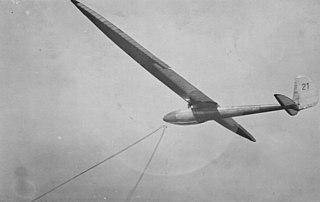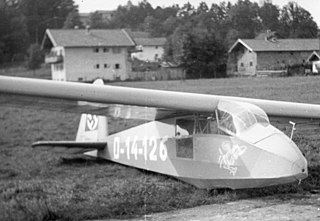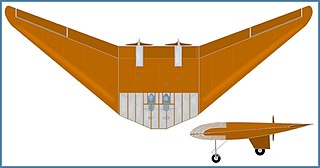
The Horten H.IX, RLM designation Ho 229 was a German prototype fighter/bomber initially designed by Reimar and Walter Horten to be built by Gothaer Waggonfabrik late in World War II. It was the first flying wing to be powered by jet engines.

The Göppingen Gö 1 Wolf was a single-seat glider produced in Germany from 1935.

The Horten H.IV was a German tailless flying wing glider in which the pilot was to lie in a prone position to reduce the frontal area, and hence drag. It was designed by Reimar and Walter Horten in Göttingen. Four were built between 1941 and 1943. They were flown in a number of unofficial competitions in Germany during World War II. After the war the flying examples were transported to the United Kingdom and the United States where several contest successes were achieved.

The SZD-20x Wampir II was a single-seat tail-less research glider designed and built in Poland from 1959.
The Airspeed AS.1 Tern was a 1930s British glider aircraft, the first aircraft built by Airspeed Limited at York and one of the earliest British-designed gliders.

The I.Ae. 34 Clen Antú, sometimes known as the Horten XVa after its designer Reimar Horten, was a two-seat tailless glider built in Argentina. Two single-seat variants competed unsuccessfully in the 1952 World Gliding Championships.

The Akaflieg München Mü3 Kakadu is a glider designed and built in Germany in 1928.

The Akaflieg München Mü10 Milan is a two-seat glider aircraft that was designed in Germany in 1934. Only one copy of the design was built.

The I.Ae.41 Urubú was a two-seat flying wing tailless glider, built in Argentina by the Fábrica Militar de Aviones (FMA) in the 1950s.

The Horten H.III was a flying wing sailplane built by Walter and Reimar Horten in Germany from 1937 to 1944.

The Schleicher Condor, also referred to as the Dittmar Condor, is a series of German high-wing, single and two-seat, gull winged, gliders that were designed by Heini Dittmar in the 1930s, produced in small quantities before the Second World War, produced again between 1952 and 1955 by Alexander Schleicher GmbH & Co and also by Ferdinand Schmetz.
The Akaflieg Darmstadt D-28 Windspiel was a single-seat, high-performance sailplane designed in Germany in the early 1930s. Intended to exploit a growing understanding of thermal soaring, it was small and manoeuvrable, with a 12 m span; silk-covered for lightness, it weighed less (empty) than its pilots. It held the world straight-line distance record for a time in 1934.

The Antonov A-9 was a single-seat sailplane designed and built in the USSR in the 1940s, a development of the record setting Red Front 7.
The Akaflieg Braunschweig SB-8 is an experimental, single-seat, high performance glider built in Germany in the 1960s, constructed largely from glass fibre skin over built up balsa wood structure. Two were built; the second of which was later fitted with a high aspect ratio (30:1) wing, becoming the Akaflieg Braunschweig SB-9 Stratus.

The DFS Rhönsperber, otherwise known as the Schweyer Rhönsperber or Jacobs Rhönsperber was a single seat competition glider designed in Germany by Hans Jacobs and first flown in 1935. For several years it was regarded as the best German sailplane and about one hundred were built.
The RRG Urubu Obs, often known just as the RRG Obs, was a one-off, large, two or three seat glider designed for meteorological observations by Alexander Lippisch in Germany and first flown in 1932.
The Horten H.II Habicht (Hawk) was a German flying wing glider built in Germany in 1935. Four, including one flown mostly as a motorglider, were built. One of the gliders was used to test the aerodynamics of a prototype World War II Horten jet fighter-bomber.

The Horten H.V was a delta-winged, tail-less, twin-engined motor-glider designed and built in the late 1930s and early 1940s by Walter and Reimar Horten in Germany. The H.V aircraft were used for various experimental duties, including: innovative structure, performance, stability and control of flying wing aircraft. The first H.V was the first aircraft to be built using an all composite material structure.
The Horten H.I was a German flying wing research glider built by Walter and Reimar Horten in 1933.

The Horten H.VII was a flying wing fighter-trainer aircraft designed by the Horten brothers during World War II.














